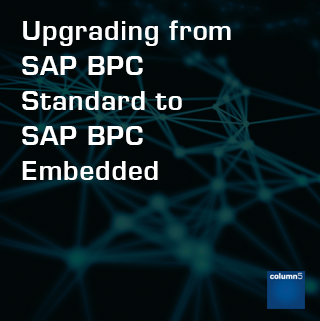 The recipe to successfully execute a project is to have a right mixture of skills within the team and a desire to deliver success shared by all members of the team. An EPM upgrade project is no exception. However, as the technology is changing so fast, there are various challenges, lessons learned, unlearned, and relearned. These contribute to extra layers of complexity when executing EPM projects successfully and this is particularly true when running projects to upgrade from SAP BPC Standard to SAP BPC Embedded.
The recipe to successfully execute a project is to have a right mixture of skills within the team and a desire to deliver success shared by all members of the team. An EPM upgrade project is no exception. However, as the technology is changing so fast, there are various challenges, lessons learned, unlearned, and relearned. These contribute to extra layers of complexity when executing EPM projects successfully and this is particularly true when running projects to upgrade from SAP BPC Standard to SAP BPC Embedded.
As there are various scenarios possible in upgrading an existing BPC system to the latest Embedded version, I would like to start with a little explanation on what options are available for existing BPC customers:
- Scenario – 1 of Figure1 below shows that an existing BW-IP / PAK system can be upgraded to BPC 10.1 Embedded in a moderately easy way, as the underlying engine for BPC Embedded is same as BW-IP engine.
- Scenario – 3 is also a simple upgrade from 10.0 or earlier NW system to a 10.1 NW Standard system. The upgrade path is similar irrespective of Standard with or without HANA.
- Scenario – 2 & 4 are both migrating from 10.0 MS / NW or earlier versions to the BPC Embedded version. In this scenario the system has to be redesigned and rebuilt. There is no easy migration path but you can leverage the learning from your previous BPC implementation to facilitate the upgrade.

Although, there are various upgrade scenarios possible, this blog focuses on upgrading your SAP BPC solution to BPC 10.1 Embedded as the target.
An upgrade could take place at any stage of the project life cycle as change in technology is creating situations that are more dynamic and challenging than ever before. For example, an existing BPC 10.0 NW system could be upgraded to 10.1 Embedded or in a new BPC 10.1 Standard implementation, during design stage, the project management board could take a collective decision to move from Standard to Embedded version of BPC. Whatever may be the situation, the challenges faced and lessons learnt are very similar. I have summarised my experience with such a design time migration from BPC 10.1 Standard to Embedded in the rest of this blog.
Check out our on-demand webcast, 10 Things You Need to Know about SAP BPC Embedded
The journey experience is very different to a normal BPC upgrade as BPC Embedded is a new product in the SAP EPM stack and requires a different skillset to be implemented. It uses a key figure based modelling approach to planning (similar to SAP BW) rather than an account based approach (as in BPC Standard). There are various challenges faced and lessons learnt during this interesting, challenging but ultimately rewarding journey. Here are a few important points that could make your journey better prepared and therefore much more enjoyable!
Tools of the trade & skillset: There are a set of new tools that are used during BPC Embedded implementation and it is worth paying careful consideration of the impact this has on the team skills you require:
- Model objects such as cubes, DSOs, Aggregation levels etc. are directly created in SAP BW data warehousing work bench and then linked to BPC models. SAP BW data modelling skills are necessary to carry out this job.
- Input forms and reports are no longer directly created in the EPM Reporting tool. BEx query designer is used to create queries which are used to create input forms and reports. Thus, BEx query designer skill is a must.
- BPC Embedded uses Analysis for Office’s analysis plug-in instead of EPM Add-in. But the good news is that none of the old EPM functions or EPM Add-in way of creating reports / input forms require a skills upgrade as the plug-in is very similar to the EPM Report writer.
- Data manager packages are replaced with planning functions and sequences which requires ABAP code or Fox formulae to be implemented. Though ABAP is not a new buzz word for BPC, Fox is. Fox formula is used instead of logic scripts in Embedded implementation so you will need some Fox skills in your BPC Embedded implementation team.
- Apart from the 4 points mentioned above, there are also advanced tools available to leverage HANA capability by writing HANA script, knowing HANA studio etc. so experience of these tools will also enhance the effectiveness of your project team.
- People with the skills above are essential for a SAP BPC Embedded project’s success so as you plan your upgrade also plan your new skills acquisition.
Contingency: It is absolutely essential to plan enough contingency in the project plan as there will be so many more dependencies on other teams or on SAP itself compared with a SAP BPC Standard project.
- Because Embedded is new, exciting and a fast developing BPC version, every project has a learning curve for the development team and for the client. Embedded project’s learning curve is a bit longer than usual (and hence the need to plan appropriate contingency).
- SAP themselves are investing a lot of time and money to make Embedded best in the industry, so there are various service packs and patches released more frequently than usual with the more stable Standard BPC versions. Get ready to upgrade your system more frequently than in the past and be prepared to face a very dynamic environment.
- There is a growing body of help available in SCN as well as other resources available over the internet. But, this advice is also new and fast developing so this dos leave the development team to do a lot of learning through trial and error, self-discovery, and remediating issues and errors. So, extra contingency to accommodate this iterative approach to knowledge acquisition is clearly very important.
Business teams vs Technology teams: It is normal for BPC consultants to work very closely with the the business owners during successful BPC Standard implementations and, indeed, co-location is often the physical manifestation of that. For Embedded projects, however, it is essential to involve IT counterparts as well and to have them engaged just as closely. Close team work and shared requirements and business objectives are key:
- SAP Embedded is more technology dependent and hence BPC Embedded implementation needs rather more focus on IT systems team than ever before.
The skill set required for business teams to own BPC Embedded system is somewhat different to BPC Standard. The BPC Embedded administrators require a good understanding of BW, BEx, analysis for office etc. which are all core parts of the BPC Embedded solution, apart from the usual BPC administration knowledge. So, recognise this early and develop Administrator skills appropriately from day one of your upgrade project. There are many other components of a successful BPC project that are common across the BPC versions, such as good planning, a clear blueprint, adequate testing, change management, end user training, clear integration design etc. However, my personal experience, with the project mentioned above, proved that these key differences, primarily in skills needed, are the most important areas that needs more focus and contributed to day-to-day challenges if not thought through in advance of your SAP BPC Embedded project commencing. So, take time to plan your Embedded BPC project if it is to be a success as just relying on your past successful BPC Standard implementation experience will not be enough.
For the right use cases though, BPC Embedded will deliver very successful projects and push BPC into levels of integration and efficiency that it would have not been possible to achieve in BPC Standard, so the effort is worth it! For assistance in evaluating a migration to BPC Embedded, contact your local Column5 representative.
Learn more about SAP BPC Embedded by checking out our upcoming live webcast, The 10 Things You Need to Know about SAP BPC Embedded:
Related Articles:
SAP BW-IP, SAP BPC NW 10.1 Standard and SAP BPC NW 10.1 Embedded Compared
Integrated Planning with SAP BPC 10.1 Standard
Useful Tips of Advanced Functionality in EPM10 Dynamic Formatting
Author Bio:
 Surya Tamada joined Column5 in June 2016 after 12 years of successfully delivering SAP EPM solutions for the clients of PwC, SAP Labs and Accenture. He is leading the Column5 EMEA SAP BPC 10.1 embedded practice, working on one of the first large-scale BPC embedded EPM projects in Europe.
Surya Tamada joined Column5 in June 2016 after 12 years of successfully delivering SAP EPM solutions for the clients of PwC, SAP Labs and Accenture. He is leading the Column5 EMEA SAP BPC 10.1 embedded practice, working on one of the first large-scale BPC embedded EPM projects in Europe.
Surya Tamada, Principle Consultant and Leader of the Column5 SAP BPC Embedded Centre of Excellence











